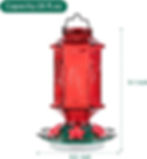Is Red-Dyed Hummingbird Nectar Safe?
You know the stuff… that bottled, cheap red liquid you see at Walmart, your local home improvement store, or even your grocery store. You may even see a neighbor giving it away on Facebook Marketplace, Craigslist, or Nextdoor. But what’s the deal? Is it even usable? Is it safe for hummingbirds? Let’s dive in and find out!

The Best DIY Hummingbird Nectar Recipe
Before we break down the safety of red-dyed nectar, let’s talk about the best homemade hummingbird nectar recipe. It’s incredibly simple!

The Best DIY Hummingbird Nectar Recipe
How to Make Safe Hummingbird Nectar:
Add 4 parts water to a small pot and bring to a boil.
Stir in 1 part plain white table sugar until fully dissolved.
Remove from heat and allow to cool to room temperature. (For faster cooling, refrigerate briefly.)
Thoroughly clean your hummingbird feeder before refilling with fresh nectar.
Hang your feeder back up and enjoy watching the hummingbirds!
This method is clean, safe, and quick. You don’t have to take our word for it—check out this resource from the Smithsonian National Zoo & Conservation Biology Institute: DIY Hummingbird Nectar Recipe


Is Store-Bought Red-Dyed Hummingbird Nectar Safe?
Examining Popular Brands
One of the most common store-bought nectar products is Perky-Pet Concentrated Hummingbird Nectar Sugar, which claims to be 100% sucrose. Since sucrose is metabolized efficiently by hummingbirds, this seems like a great option at first glance. However, there’s a major issue—it’s dyed red.
The Smithsonian and other experts recommend avoiding red dye in nectar. So why do companies like Perky-Pet continue using it? It’s likely a marketing tactic—humans are drawn to the red color, even though birds don’t need it in their nectar.

Why Red Dye is Bad for Hummingbirds?
Hummingbirds are naturally attracted to red flowers and feeders, but that doesn’t mean they need red-dyed nectar. Many experts, including hummingbird researcher Sheri L. Williamson, have publicly criticized the use of red dye in commercial nectar, noting its potential harm to birds. Despite concerns, some manufacturers continue producing red nectar without sufficient safety studies.
What are some safe alternatives to Red-Dyed Hummingbird Nectar
Instead of using commercial red-dyed nectar, opt for these safe alternatives:
Homemade or DIY nectar (recipe included above)
Clear, dye-free commercial nectar(product link here)
Decorative Hummingbird Feeders with red accents instead of red nectar (We've included the top options below for durability and review rating!)
Billion Sky Lantern Style Hummingbird Feeder with Red Glass (product link here)
Netvue Birdfy Smart Hummingbird Feeder with Solar Charging (product link here or click the image below)

Final Thoughts
So, is red-dyed hummingbird nectar safe? The answer is no. While some brands claim to be safe, red dye is unnecessary and likely harmful. Instead, opt for a simple homemade nectar recipe or a clear, dye-free alternative to keep your backyard hummingbirds healthy and happy.
Are you curious to learn more about hummingbird feeders, nectar, or other backyard birding tips? Let us know in the comments! Thanks for visiting and reading!
- BOWC (Lisa & Dan)


